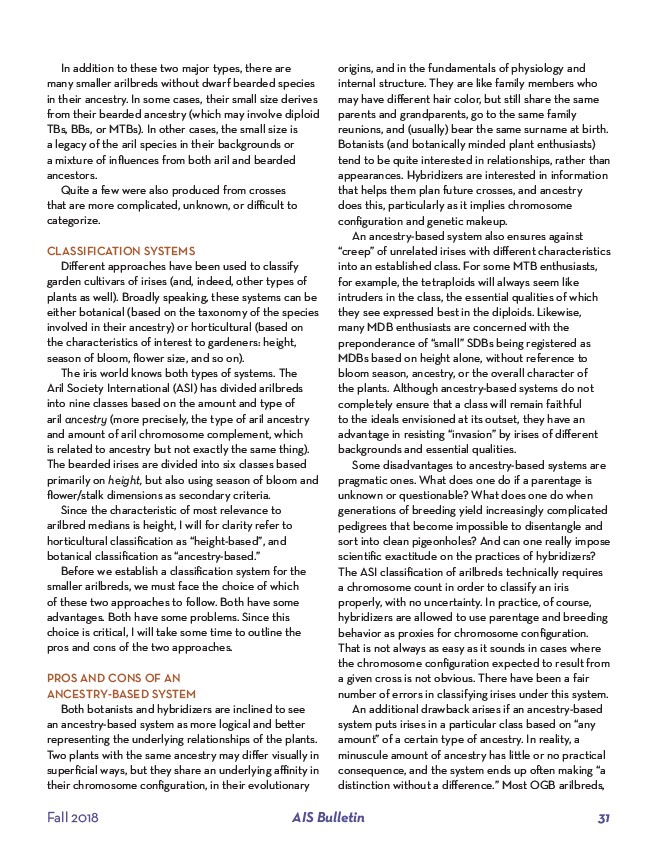
In addition to these two major types, there are
many smaller arilbreds without dwarf bearded species
in their ancestry. In some cases, their small size derives
from their bearded ancestry (which may involve diploid
TBs, BBs, or MTBs). In other cases, the small size is
a legacy of the aril species in their backgrounds or
a mixture of influences from both aril and bearded
ancestors.
Quite a few were also produced from crosses
that are more complicated, unknown, or difficult to
categorize.
CLASSIFICATION SYSTEMS
Different approaches have been used to classify
garden cultivars of irises (and, indeed, other types of
plants as well). Broadly speaking, these systems can be
either botanical (based on the taxonomy of the species
involved in their ancestry) or horticultural (based on
the characteristics of interest to gardeners: height,
season of bloom, flower size, and so on).
The iris world knows both types of systems. The
Aril Society International (ASI) has divided arilbreds
into nine classes based on the amount and type of
aril ancestry (more precisely, the type of aril ancestry
and amount of aril chromosome complement, which
is related to ancestry but not exactly the same thing).
The bearded irises are divided into six classes based
primarily on height, but also using season of bloom and
flower/stalk dimensions as secondary criteria.
Since the characteristic of most relevance to
arilbred medians is height, I will for clarity refer to
horticultural classification as “height-based”, and
botanical classification as “ancestry-based.”
Before we establish a classification system for the
smaller arilbreds, we must face the choice of which
of these two approaches to follow. Both have some
advantages. Both have some problems. Since this
choice is critical, I will take some time to outline the
pros and cons of the two approaches.
PROS AND CONS OF AN
ANCESTRY-BASED SYSTEM
Both botanists and hybridizers are inclined to see
an ancestry-based system as more logical and better
representing the underlying relationships of the plants.
Two plants with the same ancestry may differ visually in
superficial ways, but they share an underlying affinity in
their chromosome configuration, in their evolutionary
origins, and in the fundamentals of physiology and
internal structure. They are like family members who
may have different hair color, but still share the same
parents and grandparents, go to the same family
reunions, and (usually) bear the same surname at birth.
Botanists (and botanically minded plant enthusiasts)
tend to be quite interested in relationships, rather than
appearances. Hybridizers are interested in information
that helps them plan future crosses, and ancestry
does this, particularly as it implies chromosome
configuration and genetic makeup.
An ancestry-based system also ensures against
“creep” of unrelated irises with different characteristics
into an established class. For some MTB enthusiasts,
for example, the tetraploids will always seem like
intruders in the class, the essential qualities of which
they see expressed best in the diploids. Likewise,
many MDB enthusiasts are concerned with the
preponderance of “small” SDBs being registered as
MDBs based on height alone, without reference to
bloom season, ancestry, or the overall character of
the plants. Although ancestry-based systems do not
completely ensure that a class will remain faithful
to the ideals envisioned at its outset, they have an
advantage in resisting “invasion” by irises of different
backgrounds and essential qualities.
Some disadvantages to ancestry-based systems are
pragmatic ones. What does one do if a parentage is
unknown or questionable? What does one do when
generations of breeding yield increasingly complicated
pedigrees that become impossible to disentangle and
sort into clean pigeonholes? And can one really impose
scientific exactitude on the practices of hybridizers?
The ASI classification of arilbreds technically requires
a chromosome count in order to classify an iris
properly, with no uncertainty. In practice, of course,
hybridizers are allowed to use parentage and breeding
behavior as proxies for chromosome configuration.
That is not always as easy as it sounds in cases where
the chromosome configuration expected to result from
a given cross is not obvious. There have been a fair
number of errors in classifying irises under this system.
An additional drawback arises if an ancestry-based
system puts irises in a particular class based on “any
amount” of a certain type of ancestry. In reality, a
minuscule amount of ancestry has little or no practical
consequence, and the system ends up often making “a
distinction without a difference.” Most OGB arilbreds,
Fall 2018 AIS Bulletin 31